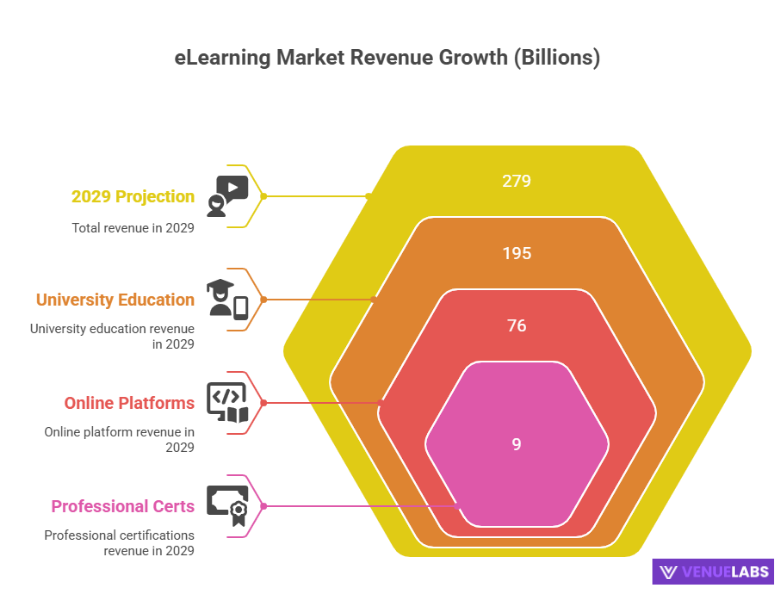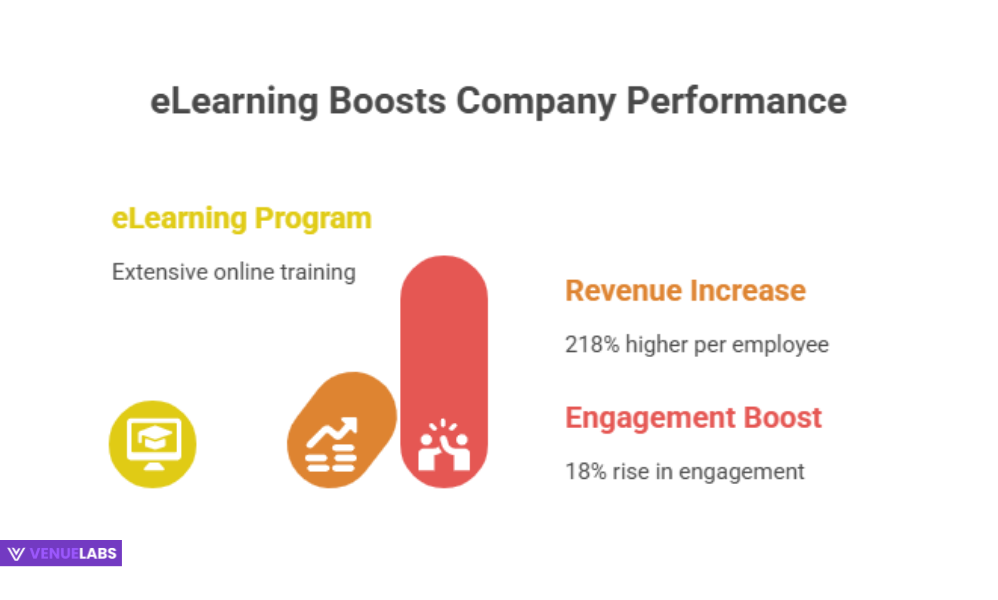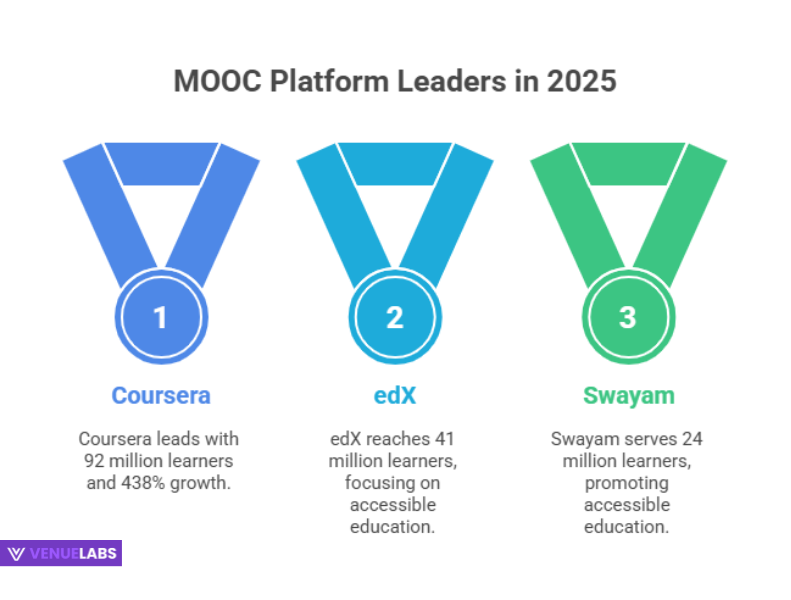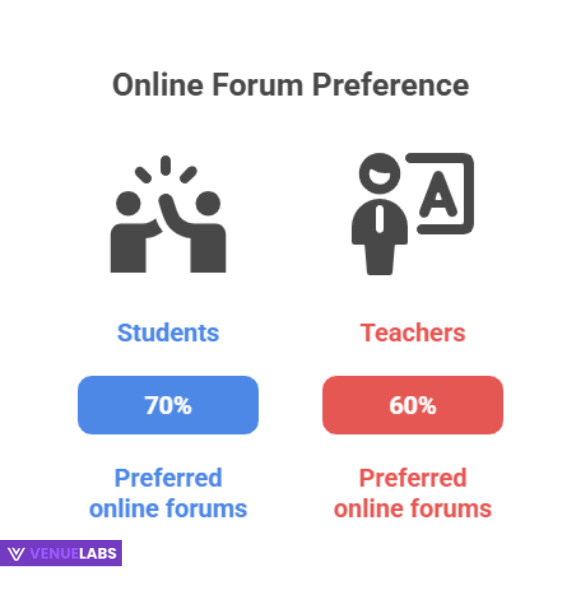The way we learn is changing rapidly, and by 2025, eLearning isn’t just an option—it’s the dominant force. From students seeking flexible education to businesses aiming for higher productivity, online learning is reshaping our world.
We are diving deep into the latest eLearning statistics for 2025, exploring market growth, student preferences, corporate training trends, and the exciting role of AI.
Get ready to understand how you can harness this powerful shift for your own success.
The eLearning Boom: A Market Exploding with Opportunity
Imagine a market growing nine times its size in just two decades. That’s exactly what the online learning sector has done since 2000, becoming the fastest-growing segment in education. In 2025, this growth continues its incredible trajectory.
A Giant Market with Massive Potential
The global eLearning market is set to reach an impressive 539.88 billion by 2028. This represents a strong compound annual growth rate (CAGR) of 14.1% from 2024 to 2028, showcasing a vibrant and continually evolving marketplace.
Let’s look at the incredible journey of online learning revenue:
| Year | Predicted Online Learning Revenue |
| 2023 | $166.60 billion |
| 2024 | $185.20 billion |
| 2025 | $203.80 billion |
| 2026 | $220.80 billion |
| 2027 | $239.30 billion |
| 2028 | $259.00 billion |
| 2029 | $279.30 billion |
Source: eLearningstats.education
Where the Money Flows: Key Segments of the eLearning Market

The vast eLearning market isn’t a single entity; it’s composed of several powerful segments, each contributing significantly to its overall revenue.
- Online University Education will lead the charge, projected to generate a staggering $120.70 billion. This includes everything from full online degrees to individual college courses, highlighting how traditional higher education is embracing digital delivery.
- Online Learning Platforms like Coursera, Udemy, and Skillshare are essential hubs for knowledge, expected to generate $58.45 billion. These platforms offer diverse courses for personal and professional development.
- Professional Certificates are also a significant contributor, anticipated to bring in $6.04 billion. These specialized courses equip individuals with specific job skills, bridging the gap between education and employment.
Here’s a more detailed look at global revenue for online learning platforms:
| Online Learning Segment | 2024 | 2029 (Projected) |
| Online Learning Platform | $56.69 billion | $76 billion |
| Online University Education | $85.50 billion | $195 billion |
| Professional Certificates | $4.68 billion | $9 billion |
| Total Online Learning Revenue | $185.20 billion | $279 billion |
Source: Statista.
Students Speak: Why Online Learning is Their Top Choice
If you’re a student, understanding these trends helps you make informed decisions about your education. The numbers clearly show a strong preference for online learning.
1. Unparalleled Flexibility and Better Retention

Students love online learning for its flexibility. A significant 69% of students worldwide say they prefer fully online, hybrid, or blended learning options. Only 31% prefer traditional face-to-face instruction.
This flexibility allows individuals to integrate learning seamlessly into their busy lives, whether balancing work, family, or other commitments.
Beyond convenience, online learning actually helps you learn better! Studies show that students retain 25% to 60% more information through online learning compared to the 8-10% in a traditional classroom. This improved retention is often due to the self-paced nature of online courses and the ability to revisit materials as needed.
- 96% of online college students would recommend online learning. This overwhelming endorsement speaks volumes about the positive experiences students are having.
- 81% of students report that digital learning tools helped them achieve better grades. This highlights the effectiveness of online resources in improving academic performance.
- 60% of online students also improved vital “soft skills” like communication, teamwork, and time management, skills crucial for any career path.
2. The Power of Video and Digital Tools
Engaging content is key to effective learning, and online platforms excel here. 95% of learners state they retain information effectively with video-based educational materials. Visual learning is incredibly powerful, and online courses leverage this by incorporating rich multimedia.
Moreover, 85% of teachers utilize digital learning tools to boost student engagement. Educators are actively incorporating technology, recognizing its potential to create dynamic and interactive learning environments. Seven out of ten teachers also agree that these tools are very helpful for students studying independently.
eLearning in the Corporate World: Boosting Productivity and Profits
For business leaders and managers, eLearning isn’t just about training; it’s a strategic investment that drives growth and enhances employee satisfaction.
1. Higher Revenue, Happier Employees

Companies that embrace eLearning see significant returns. Those with extensive online training programs generate an astounding 218% higher revenue per employee. This is a massive return on investment, making a clear business case for digital learning.
Beyond the bottom line, eLearning significantly impacts employee morale and engagement. Employee engagement rises by 18% with the use of eLearning. When companies invest in their employees’ growth through accessible and flexible online training, it fosters loyalty and a more motivated workforce.
2. Time and Cost Savings: The IBM Success Story
One of the most compelling advantages of eLearning in the corporate setting is its efficiency. Online learning often requires 40% to 60% less employee time compared to traditional classroom training. This means employees can acquire new skills faster and get back to their core responsibilities.
IBM famously demonstrated the power of eLearning by saving $200 million after switching to online training. They found that every dollar invested in online training resulted in $30 of productivity. This remarkable example highlights how eLearning can drastically reduce training costs while simultaneously increasing employee output.
- 93% of businesses globally plan to adopt eLearning methods for their teams, indicating a widespread recognition of its benefits.
- Approximately 40% of Fortune 500 companies worldwide use eLearning for training, a testament to its proven effectiveness among industry giants.
- 61% of experts prioritize closing the skill gap through eLearning, acknowledging its role in keeping their workforce competitive and adaptable.
Global Reach: Who is Learning Online?
Online learning transcends geographical boundaries, making education accessible to millions worldwide.
1. Demographics of the Online Learner
The average age of an online student is 32 years globally, showing that online learning appeals to a broad demographic, from recent graduates to experienced professionals seeking to upskill or reskill.
On platforms like Coursera, the gender split is nearly even, with 53% male and 47% female learners, reflecting widespread appeal.
2. Top Countries Leading the Charge

While online learning is a global phenomenon, some regions and countries have a higher concentration of learners.
- Asia Pacific has the highest student presence on eLearning platforms, with 28 million new online learners enrolling in 68 million courses. This region is a powerhouse of online education.
- The United States leads in the sheer number of eLearners, with 17.3 million registered on Coursera alone. India follows closely with 13.6 million learners.
Here’s a snapshot of the top countries with the most learners on Coursera:
| Country | Number of Learners |
| United States | 17.3 million |
| India | 13.6 million |
| Mexico | 4.8 million |
| Brazil | 3.7 million |
| China | 3.3 million |
| Canada | 2.4 million |
| Russia | 2.4 million |
| United Kingdom | 2.4 million |
| Colombia | 2.2 million |
| Egypt | 1.6 million |
Interestingly, while some countries have high learner numbers, others are experiencing rapid growth in new online learners:
| Country | Growth Rate of Learners |
| Paraguay | 98% |
| Lebanon | 97% |
| Philippines | 85% |
| Guyana | 74% |
| Indonesia | 74% |
| Kenya | 69% |
| Ethiopia | 61% |
| Rwanda | 60% |
| Vietnam | 55% |
| Kazakhstan | 54% |
MOOCs, LinkedIn Learning, and the Pandemic’s Enduring Impact
Massive Open Online Courses (MOOCs) continue to be a significant force, and the COVID-19 pandemic accelerated the adoption of eLearning, leaving a lasting legacy.
1. The Rise of MOOCs

The MOOC market is projected to reach $21.4 billion by 2025, demonstrating the immense popularity of these large-scale online courses. North America currently contributes the highest to this market with a 29.4% share, though the Asia Pacific region is expected to have the highest annual growth rate in the coming years.
Coursera stands out as the most preferred MOOC platform, boasting over 92 million learners as of 2023, a three-fold increase since 2018. It partners with over 275 universities and companies, offering a vast array of courses and degrees.
Other prominent MOOC platforms include:
| Course Name | Learners | Courses | Degrees |
| Coursera | 92 million | 4600+ | 25 |
| edX | 41 million | 3500+ | 13 |
| FutureLearn | 17 million | 1160+ | 28 |
| Swayam | 24 million | 1130+ | 0 |
- Also read about: Edx vs Coursera
2. LinkedIn Learning and Specialized Platforms
LinkedIn Learning has also established itself as a key player in professional development. It boasts over 27 million registered users and offers around 20,800 courses in 11 languages, making it a go-to resource for career-focused learning. Similarly, MasterClass thrives with over 2 million active subscribers, many of whom are women (51.28%), emphasizing niche platforms’ success.
3. COVID-19’s Lasting Legacy on eLearning

The pandemic undeniably acted as a catalyst for eLearning. In 2020, when 50 nations shut down schools, 18% of students worldwide registered on eLearning platforms. This rapid shift normalized online learning and revealed its immense potential.
- 60% of students found online forums and discussions helpful, a significant increase from less than 30% pre-pandemic. This highlights the effectiveness of virtual collaboration.
- 70% of students and 60% of teachers preferred online forums and hybrid learning over face-to-face during the pandemic, showing a sustained preference for blended models.
- Educators noted that students could cover up to 50% of content independently with eLearning, empowering self-directed learning.
What Users Are Asking: Emerging Trends from Quora and Reddit
Beyond the statistics, real-world questions on platforms like Quora and Reddit reveal key concerns and interests from the eLearning community.
- “How do I choose the best online course platform for my specific needs?” Users are looking for personalized guidance, focusing on factors like accreditation, instructor quality, community support, and career impact, not just price.
- “What are the most effective strategies for staying motivated in an online course?” This common question highlights the need for effective self-regulation techniques, community engagement, and progress tracking tools within online learning environments.
- “How can I leverage AI tools to create better eLearning content?” Content creators are actively seeking practical advice on using AI for scriptwriting, image generation, personalized feedback, and automated assessments to enhance their courses.
- “Are online professional certificates truly recognized by employers?” This points to a desire for reassurance regarding the value and industry acceptance of digital credentials.
- “What’s the best way to network and collaborate with peers in an online learning environment?” Learners are seeking ways to replicate the social and collaborative aspects of traditional education in a virtual setting.
These questions emphasize that while the statistics show massive growth, the human element—motivation, practical application, community, and credibility—remains central to successful online learning.
The Challenges of Online Learning: What We Need to Address
Despite its many advantages, eLearning faces significant challenges that demand attention from educators, policymakers, and companies.
1. The Persistent Digital Divide
The “digital divide” remains the biggest and most serious problem. Not everyone has equal access to the necessary tools for online learning.
In the United States, 25% of low-income students have limited access to reliable computers or high-speed internet. This creates a major disadvantage, widening educational inequalities.
2. Screen Time and Security Concerns
Both parents and educators worry about the health effects of excessive screen time. 36% of K-12 educators view increased screen time as a major challenge of digital learning. This can lead to eye strain, poor posture, and reduced physical activity.
Security is another critical concern, especially for younger learners. School devices often have low antivirus compliance rates, making them vulnerable to security risks.
Ensuring students are protected from inappropriate content and cyber threats in an online environment is an ongoing challenge.
FAQs About eLearning Statistics
1. How large is the eLearning market expected to be in 2025?
The global eLearning market is projected to reach an impressive $320.96 billion in 2025, demonstrating its rapid expansion and significant economic impact worldwide.
2. Why do students prefer online learning over traditional classroom settings?
Students primarily prefer online learning due to its flexibility, allowing them to balance education with work and personal commitments, and because studies show they retain 25% to 60% more information through online methods.
3. How does eLearning benefit businesses and corporate training?
eLearning offers substantial benefits to businesses, including significantly increased employee engagement (18% higher), higher revenue per employee (218% more), and considerable time and cost savings compared to traditional training methods.
4. What role does AI play in the future of eLearning?
AI is playing a transformative role in eLearning by powering learning management systems, boosting student engagement by 80% through personalized content, and saving course creators over 26 hours a week in content development.
5. What are the main challenges facing the eLearning industry today?
The primary challenges include addressing the digital divide, ensuring equitable access to technology and internet for all learners, and managing concerns around increased screen time and online security for students.
Also Read:
- Internet User Statistics
- Google Ads Statistics
- PayPal Statistics
- Digital Marketing Statistics
- WhatsApp Statistics
Conclusion: eLearning is Essential and Thriving in 2025
In 2025, eLearning is no longer a niche alternative; it is an essential component of education and professional development. The global market is nearing $321 billion, with 93% of businesses planning to adopt eLearning methods.
Student retention rates are up to 60% higher than traditional learning, making it an unavoidable option for both teachers and learners. Platforms like Coursera and edX continue to lead, while the Asia Pacific region and the U.S. dominate learner counts.
With the transformative power of AI and the continuing legacy of the pandemic, the shift to digital learning is not just growing; it’s thriving.
As we navigate this evolving landscape, understanding these eLearning statistics for 2025 empowers us to harness the benefits and address the challenges, ensuring a more accessible, engaging, and effective future of learning for everyone.
